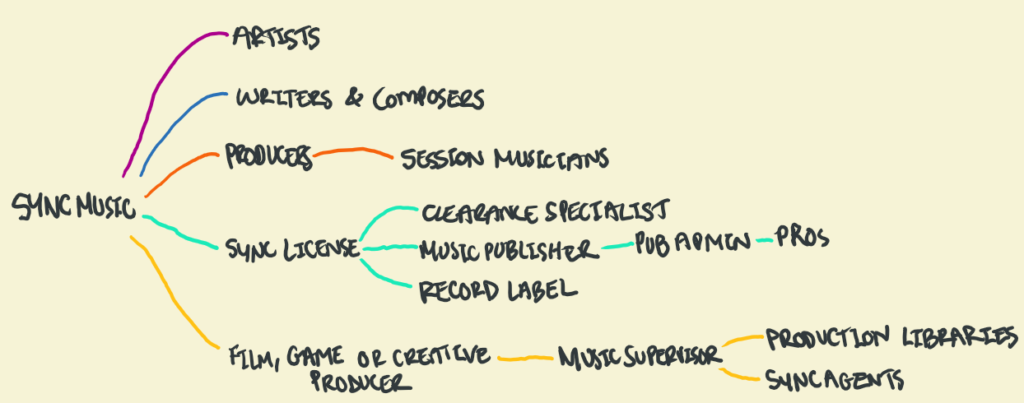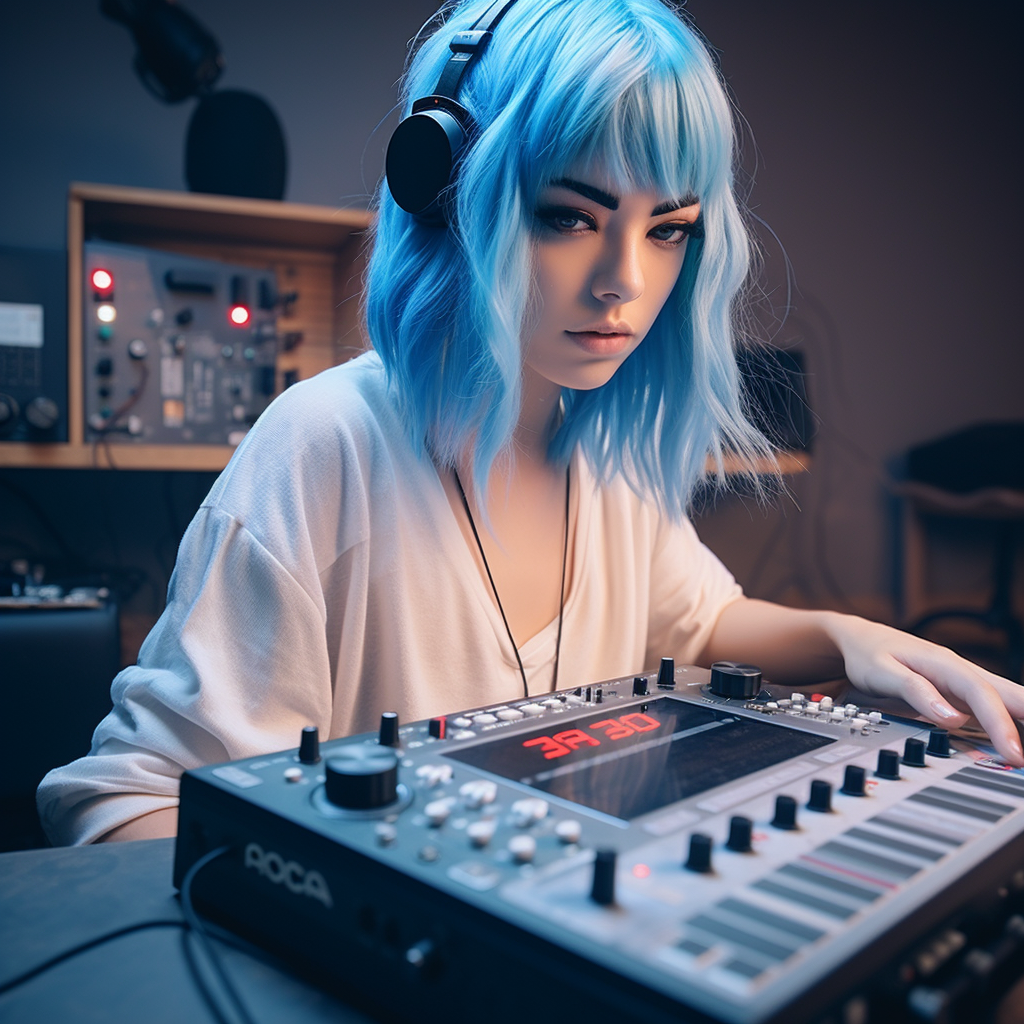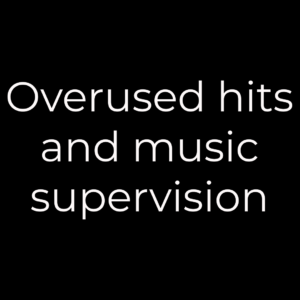Sync music: the basics
I AM NOT ACTIVELY WORKING AS A SYNC AGENT (NOR DO I WANT TO).
The information below will teach you how to be your own sync rep.
If you still need help with sync after reading this information, you should book a consultation. There is no point emailing me asking me to "collaborate" with you by representing your sync catalogue for a commission. If you want to see success, commit to investing in it.
Synchronisation (sync for short) refers to the use of music in combination with visual media, such as film, television, advertising, video games, and other forms of visual media. It involves licensing music for use in these media and can be an important income stream for artists, producers, and record labels.

What is sync music?
The term “sync music” refers to music that is either:
- Made for the purpose of being used with visual media
- Written and produced in a way that makes it more likely to be synced with visual media
- Used frequently or shortlisted for use in visual media
There are different types of music synchronisation, depending on how it is used in the medium. For example, if the characters are aware of the music, it is called diegetic or “source” music. There is also soundtrack and trailer music, which is sometimes more involved with marketing the medium than being a part of it.
What makes something “sync music”
Music becomes sync music if it meets any of the following criteria:
- It was written with synchronisation in mind, meaning it was composed around frequently present topics, moods or atmospheres.
- It is part of a “sync library,” where visual producers and music supervisors go to find low-barrier music for their projects.
- It has already been synchronised.
A song synced with music is also referred to a “placement”, and music is “placed” in syncs.
Scores
I consider scores as a slightly different business from sync music, although they’re so related they’re practically twins.
Where sync music is music that already exists outside of a visual production, a score is written specifically for the scenes within the visuals and will synchronise perfectly with what the viewer is seeing.
Whilst the differences may be subtle, the business of sync versus score is quite different.
Composers and songwriters who are hired to write scores typically write exclusively for the entire production. The music itself can be quite avant-garde or atmospheric in a way that doesn’t make much sense away from the visual media. However, many scores can be even better and more loved than the visual medium itself.
Production music
Production music refers to music specifically written for sync that is included in “sync libraries” or “production libraries”. This type of music is not primarily made for commercial release, although it is becoming more common in the streaming age, particularly with the advent of the “Epidemic Sound” model.
The production music business differs from commercial sync music in that the rights are owned by the production music company itself, rather than being controlled by multiple rights holders. Production music is typically offered to the film market at a significantly discounted rate compared to commercial music, as it lacks the added value of an artist’s brand and fandom that could draw more people towards the soundtrack and film.

Due to this, a lot of production music is created to imitate the style of commercial artists, allowing visual productions to use music that is similar to reference tracks they have used without paying the higher license fee. Additionally, the “one-stop clearance” offered by production music makes it an attractive option when budgets for music are limited.
To avoid confusing terminology, sync agents and music publishers often refer to all music they represent as “music catalogues” or “sync catalogues”, distinguishing them from “production libraries”.
Production libraries employ in-house producers, composers, songwriters, singers, and musicians to create music for their libraries. Typically, they send out periodic briefs to build collections of music that they have determined are in higher demand in the sync market.
What is the sync music industry?
The sync music industry is the people and operations that make up the complex business models that exist around the various visual and musical projects that come together to create a sync.
I go into much more detail about these aspects in the jobs in the sync music industry section of this series.

Why is it important for artists, producers and record labels to be thinking about sync?
“Sync” has been everyone’s favourite buzzword for a while because, at the highest potential opportunities, a single sync fee can be enough for someone to live off for a year.
For this reason alone, it is worth investing some of the energy from a holistic artist development strategy into sync.
However, there are different tiers of syncs, ranging from high-value opportunities to “micro syncs”, which are essentially forms of user-generated content (UGC). Therefore, it is important to cover all of these tiers as part of the sync strategy.
What do syncs pay?
Sync fees can vary depending on a wide range of factors, including the length of the license usage term, the popularity and recognition of the music and artist, the territories where the song is licensed, the type of production, the number of seconds of the music used, the frequency of the song’s appearance in the production, and more.
High tier / AAA
For your biggest syncs, such as the biggest blockbusters, you could expect a six-figure “all-in” deal. However, these kinds of deals are typically only available to superstars who have leverage.
The term “all-in” means that the payment covers both aspects of the sync licence, which I will explain in more detail below.
Mid tier
Most lucrative syncs fall into this category. They are usually 4 or 5 figures and cover everything from Netflix syncs, adverts to many AAA game sync fees.
Low tier
New smaller indie game studios, independent film producers, influencers and social media campaigns don’t have as much budget and it’s not uncommon to see 2 figure sync fees here.
So, how much money can you earn from sync music?
The amount of money you can earn by making sync music obviously depends on a whole bunch of factors. However, it’s generally accepted in music publishing that you won’t make a profit on your efforts for at least 5 years.
You should not expect to receive high-tier deals unless you are already commercially successful as a musician, artist, writer, or producer. While not impossible, it’s not something you should expect.
After approximately two years of navigating the music sync industry, you can expect to earn an early five-figure income for your efforts. This is, of course, assuming that your music is of high quality, and that you have devoted significant effort to creating valuable and genuine relationships with industry professionals who have the ability to place your music.

How does a sync license work?
Sync licenses grant permission to licensees (producers of visual media) to use music that the licensors (rights holders) control.
However, obtaining a sync license alone is not enough. A master license is also required. Therefore, two contracts must be signed when licensing music for sync, and both copyright holders (the master and publishing) must sign agreements.
The rights of a recorded song
A recorded song involves two copyrights:
- The master copyright: which protects the recording
- The publishing copyright: which protects the song (lyrics & melodies)
This is why two licenses are required for sync permission.
There are also other rights to consider in this context, such as moral rights and neighbouring rights, but we’ll cover them in future discussions.
Who is involved in a sync deal?
A sync deal involves several parties, including the sync agent who represents the artist or rights holder, the music publisher who represents the songwriters and composers, the record label who represents the master recording, and the producer or director of the visual media who seeks to license the music for their project. Additionally, a music supervisor is also involved in a sync deal. They are responsible for selecting and placing the music in the visual media, and work closely with the producer or director to achieve the desired musical effect.

What are the basics of a sync deal?
The basics of a sync deal involve obtaining both a sync license and a master license. The sync license grants permission to licensees to use music that the licensors control, while the master license is required for the use of the recording. A sync deal involves several parties, including the sync agent, music publisher, record label, producer or director of the visual media, and music supervisor. Various terms and conditions are involved in a sync deal, including clearance for sync, exclusivity, and terms. Payment for sync music can include a sync fee and back-end royalties, which may include blanket licenses.
An example of a sync license agreement
- Parties: Identify licensor (music owner) and licensee (user).
- Music Description: Details about the musical composition.
- Visual Content: Description of the media where music will be used.
- Scope: How music will be synchronised and used.
- Duration/Territory: Licence time and location limits.
- Fees: Sync fee and possible royalties.
- Rights Granted: Specific usage rights granted.
- Exclusivity: Exclusive or non-exclusive rights.
- Cue Sheet: Documentation for royalty tracking.
- Credit: How music will be credited.
- Indemnification: Responsibilities and liabilities.
- Termination: Conditions for ending the agreement.
- Governing Law: Jurisdiction and dispute resolution.
- Signatures: Signatories and effective date.
A bit more about sync deal terminology
Sync representation agreement
A sync representation agreement differs from a sync licence in that it allows someone else to represent your music for synchronisation purposes with autonomy. These agreements are offered by sync agents, and it’s important to check details such as territories and term exclusivity.
Clearance for sync
To legitimise a sync, the songs need to be “cleared” which means permission needs to be obtained from all controllers of the copyright. This can be very tricky as both the master and publishing copyrights carry reason that there might be multiple rightsholders.
Master rights splits
Master rights can be be split:
- Between different artists involved in the song (such as when there is a collaboration track)
- Between multiple members of a band
- With a producer
In the situations described above, it is best to sign a split sheet and make an agreement that allows anyone to sign off on sync agreements without the permission of others, where possible.
When you sign your music to a record label, they become the exclusive controller of the master for a specified term. This is similar to renting out a house to a tenant; during the term, the tenant has rights and control over the house, and pays rent for those rights. Similarly, the record label pays you royalties for your music during the term. However, you don’t technically hold the rights to that music during this time, but receive a percentage of the revenue.
This means you would need the record label’s permission to pitch this music for sync, and the licensee would also need to obtain permission from the record label.

Music publishing rights splits
Music publishing rights are actually two separate rights, often referred to as a “200 point system”. These are the writer’s share and the publisher’s share. If the writer is not published, they should still collect their share of royalties from publishing. One of the easiest ways to do this is by partnering with a publishing administration company.
Both sides of the publishing right can be split between:
- Multiple songwriters and composers can make things complicated, as is evident in examples of Beyonce’s songs. The media highlights cases where there are 8 or more writer credits.
- Sometimes the producer
- Rarely, but occasionally session musicians
Again, a split sheet with written agreement of who can sign off for sync agreements is essential here.
One stop
Navigating the right holders that need to be contacted in order to clear music for sync can prove to be very tricky for a licensee. There is often chaos in some visual medium industries, which may result in music clearance being left until the last minute. As a result, many sync agents and music supervisors prefer “one-stop” music.
One stop means one person can sign off for the master and publishing rights to a song.
Samples
As a rule, samples should be avoided in music production for sync. Even using just a second of a sample in a song increases the number of rights holders from a minimum of 2 to a minimum of 4. This escalation can make clearing a song “too hard” when either the song or the sample is not one-stop. Consequently, a music supervisor may opt for another track for the project.
A question that I am frequently asked is whether stock DAW samples or licensed samples count towards this “avoid samples” rule.
The complicated answer is that any sample could technically be cleared if the rightsholders are known. It is not impossible to clear samples. However, if there is any doubt that you do not have every rightsholder’s signature on paper to give to the music supervisor, it is generally best to omit used samples or avoid starting projects using them if you plan on pitching the songs for sync considerations.
That said, you could consider re-recording samples if you know it won’t infringe on publishing rights. For example, if you had flipped a sample into a new melody.

Exclusivity
Exclusivity in synchronisation contracts refers to the terms under which music can be used in a visual medium. An exclusive sync means that the licensee has the right to be the only one to use that piece of music in their project, or in a specific territory or medium, for a set period of time.
This can be attractive to both the licensor and the licensee, as it ensures that the music will not be overused and will remain fresh and unique. However, exclusivity can also limit the licensor’s ability to license the same music to other projects during the exclusivity period.
Non-exclusive syncs allow the licensor to license the same music to multiple projects at the same time, which can be more profitable in some cases. The terms of exclusivity will be negotiated between the licensor and licensee before the sync license is granted.
The decision of whether a sync should be exclusive or non-exclusive depends on the project requirements, the licensor’s goals, and the licensing agreement between the parties involved. However, exclusivity is more common in high-value sync deals, such as blockbuster films or high-budget advertising campaigns. In such cases, the licensees may want to ensure that the music is not used in other projects during the exclusivity period, which can range from a few months to a few years. On the other hand, non-exclusive syncs are more common for lower-value sync deals, such as independent films or user-generated content.
Terms
The term of the contract is the legal way of saying “duration” of the agreement.

Getting paid for sync music
The sync fee
It is a well-known fact in the industry that having expectations about when you will receive your sync fee payment is likely to lead to disappointment. The sync fee payment can take a long time to process due to:
- Negotiation: Time spent finalising terms.
- Project Timeline: Linked to project completion.
- Cue Sheet: Needed for royalty tracking.
- PRO Processing: Months for accurate allocation.
- Payment Schedule: Varies in agreement.
- Accounting: Dependent on licensee processes.
- Agreement Terms: Payment terms in contract.
- Payment Processing: Method and international factors.
- Disputes: Legal issues can cause delays.
- Errors: Administrative mistakes can occur.
I have witnessed situations where it has taken over two years for a client to receive their fee because the studio did not release the funds due to a legal issue during the production stages. Although the majority of sync fees are paid promptly once the production is released to the public, it is important to be aware of these eventualities. It should never be deemed as acceptable or commonplace.
Back-end royalties
Back-end royalties are paid for the use of commercial music in visual media that is broadcasted on TV networks or anywhere where there are “re-runs” or changes in territories licensed to play that media.
This includes music that is part of a film or television soundtrack, or music that is used in advertising, video games, and other forms of visual media. The timing of payment can vary based on the distribution of the collected data and the specific terms of the sync deal. It can take several months or even years for back-end royalties to be paid to the rights holders.
Back-end royalties in sync are paid after the production has been released and the performance data has been collected. The timing of payment can vary based on the distribution of the collected data and the specific terms of the sync deal. It can take several months or even years for back-end royalties to be paid to the rights holders.
Cue sheets
A cue sheet is a document that lists all of the music used in a visual production, along with the duration of each use and other relevant information. It is used to track and report the use of music in visual media for royalty payments.
Back-end royalties are paid to the rights holders based on the information in the cue sheet. This includes music that is part of a film or television soundtrack, or music that is used in advertising, video games, and other forms of visual media.
The process of collecting and distributing royalties is managed by Performance Rights Organisations (PROs). PROs collect and distribute royalties for the use of music in visual media. The royalties are paid to the rights holders based on the information in the cue sheet, which is submitted by the licensee (producer of the visual media).
Blanket licenses
A blanket licence is a type of licence agreement that allows licensees to use an entire catalogue of music rather than obtaining individual licences for each individual song or composition.
In the context of sync music, a blanket licence can be useful for music supervisors or production companies that need to quickly obtain rights to a large number of songs or compositions for use in their projects.
The blanket licence can be obtained from a Performance Rights Organisation (PRO), which represents the rights of multiple songwriters and publishers. The PRO will collect a fee from the licensee, which is then distributed to the rights holders.
Blanket licences can be a cost-effective solution for licensees, as they provide access to a large catalogue of music for a single, negotiated fee. However, they may not provide the same level of control or flexibility as individual licences, and the fee structure may not be suitable for all projects.
Next: My work in sync >>
Blog posts about sync
Understanding music industry market share: a guide for independent artists, labels, and music tech startups
What is the music industry market share? Market share in...
Read MoreWhy is compiling an old familiar soundtrack in sync and music supervision considered such a good thing?
Something that always really annoys me in sync (but, admittedly,...
Read More
